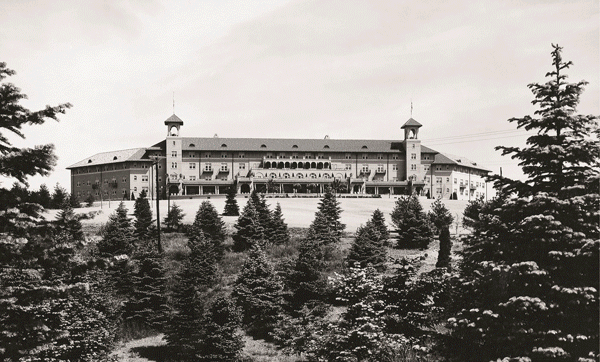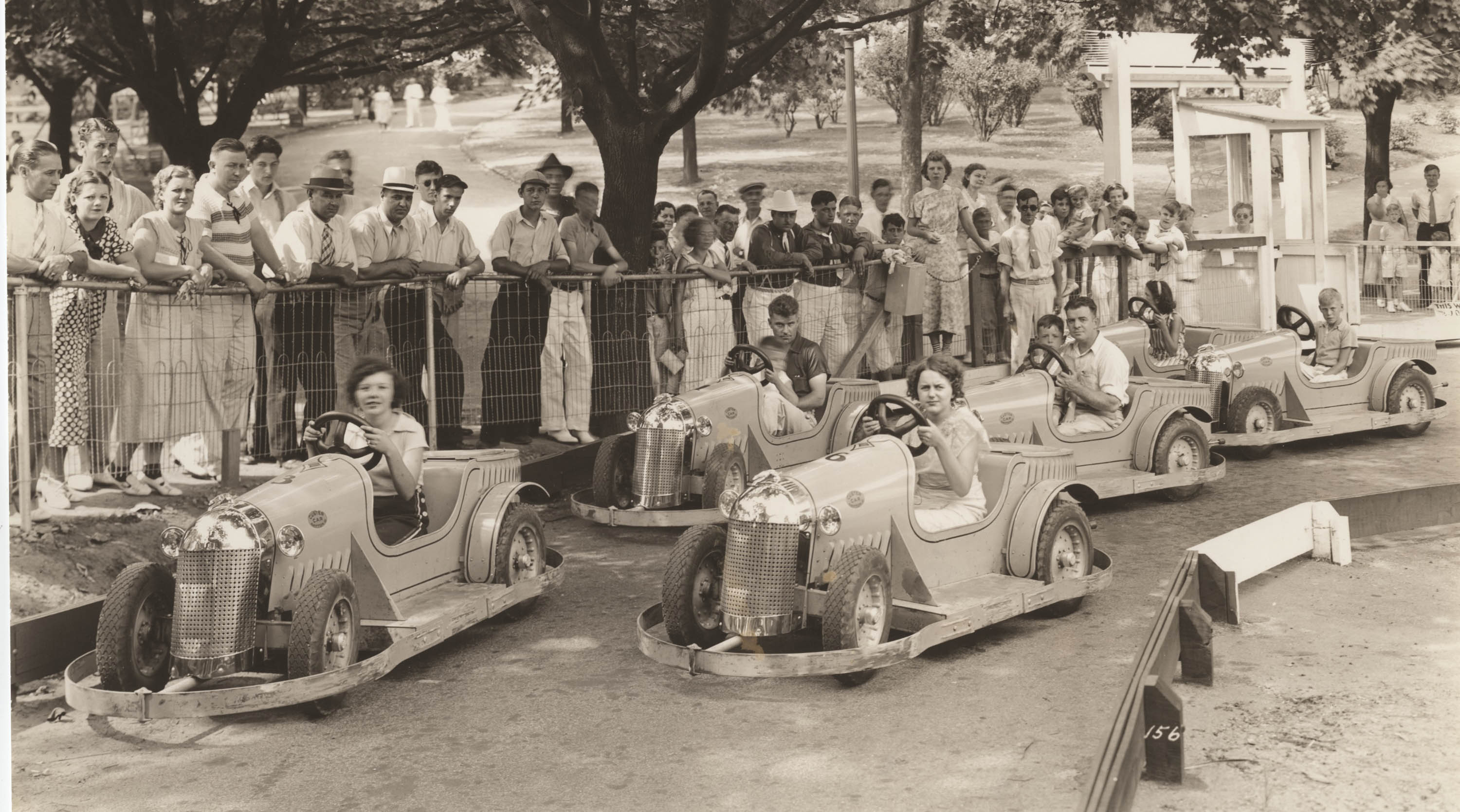Hershey's Historic Spaces
Many people associate candy maker Milton S. Hershey with the Great American Chocolate Bar, but did you know that he created hundreds of jobs during the Great Depression?
Mr. Hershey’s “Great Building Campaign” not only strengthened the local economy during a nationwide crisis but left us with some of the town’s most iconic and historic buildings, including The Hotel Hershey® and Hershey Theatre. Let's take a look at "the town that Milt built."
The Great Building Campaign
When asked what it was like in Hershey during the Depression, locals remarked, “What Depression?” Amid the fallout from the stock market crash in 1929, Hershey’s chocolate company continued to see comfortable sales and profits due to the affordability of his candy bars and products. More importantly, Mr. Hershey cared deeply for his town and all the people in it. With the low-cost building materials and available workforce, Milton Hershey gave 600 construction workers a new purpose and food on their table.
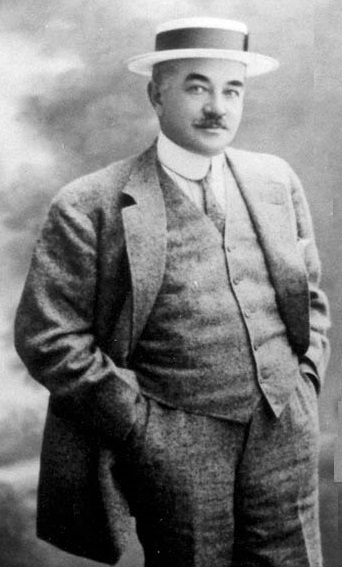
“Mr. Hershey watched intently as two huge steam shovels tore apart the earth. His foreman told him, ‘These machines do the work of 40 men." And Mr. Hershey simply replied, ‘Take them off. Hire 40 men.’
- HersheyArchives.org
The Hotel Hershey
The Hotel Hershey, opened in 1933, is one of our region’s finest hotels, but for Mr. Hershey, it was the crown jewel of the attractions and amenities he built in the town of Hershey. Mr. Hershey’s travels around the country and abroad inspired its design. The idea for the Hotel’s exterior came from a small 30-room Mediterranean hotel on the water where Mr. Hershey stayed. His hotel would have 170 rooms and sit atop Pat’s Hill overlooking the town of Hershey instead of the sea.
The building's design is heavily influenced from Mr. Hershey's travels in Cuba and European countries. The Fountain Lobby features Spanish architecture that resembles an outdoor courtyard patio with a water feature and sky-like ceiling. While you’re enjoying a Hershey’s Signature Chocolate Martini in the Iberian LoungeSM, observe its Spanish motif, including lush carpets, comfortable chairs, cozy fireplace, oak columns, and an original mural depicting a waterfront scene.
The Hotel Hershey has several world-class restaurants, including The CircularSM dining room. Mr. Hershey, who often dined alone on his travels, resented having to dine in a corner. When designing The Circular, he insisted that his restaurant have a round shape without central pillars or obstructions. This way, all his guests could have a good table.
Hershey Theatre
In 1915, Mr. Hershey had his architect draw up plans for a community building and theatre, but it wasn’t until 1928 that he dusted off the sketches, and workers broke ground.
The interior design of the Hershey Theatre evokes an early twentieth-century opulence, with an elegant grand lobby and a romantic, European-inspired opera house. Upon entering the lobby, you’ll find polished Italian lava rock floors, marble walls, and a ceiling mural depicting Greek gods, chariots, wheat, beehives, and pastoral scenes. In the back of the house, don’t forget to look up at the shimmering, intricate gold mosaic made of hand-placed tiles that took two years to place.
Inside the 1,904-seat auditorium, its pink granite walls resemble marble blocks and a suspended atmospheric ceiling makes you believe you’re outside in an Italian plaza. The symbol of the Hershey Theatre is a lion, and you’ll find 25 lions (some obvious and not so obvious) all around the room. The Hershey Theatre also has a rare Aeolian-Skinner concert organ with 4,715 pipes and 25 bells that are used for special performances.

According to lore, Mr. Hershey’s favorite seat in the Hershey Theatre was Row T, Seat 27. Row T was known as “King’s Row” because it was the first row with a gentle slope, allowing guests to see over the person in front of them. He preferred to sit on an outside aisle seat near the door so he could step out to smoke a cigar during intermission and leave as soon as the performance concluded.
- HersheyArchives.org
The Theatre opened in September 1933 with a movie showing of Pilgrimage. The venue was a regular stop on the vaudeville circuit through the 1930s. In the 1940s, the Hershey Theatre showed first-run pictures and welcomed touring Broadway companies. Today, Hershey Theatre is home to the top touring Broadway shows, famed singers and comedians, choirs, dancers, and performers of all genres.
Take a Tour: The Hershey Theatre offers Spotlight Tours on most Fridays at 11 AM for $10 (ages 3-12) and $15 for adults.
Hersheypark Arena
Hersheypark® Arena was the engineering marvel of its time - built in 1936 as the first large scale barrel shell roof structure in the country.
The Arena served as the home ice for the Hershey Bears®, the longest consecutive running hockey club in AHL history. (And the winningest club! The Bears have skated to a record 13 AHL Calder Cup Championships over the years.)
The venue of course hosted ice skating events and was also used as a multi-purpose performance and sports venue. At the Arena in March 1962, Wilt Chamberlain netted his historic 100-point game.
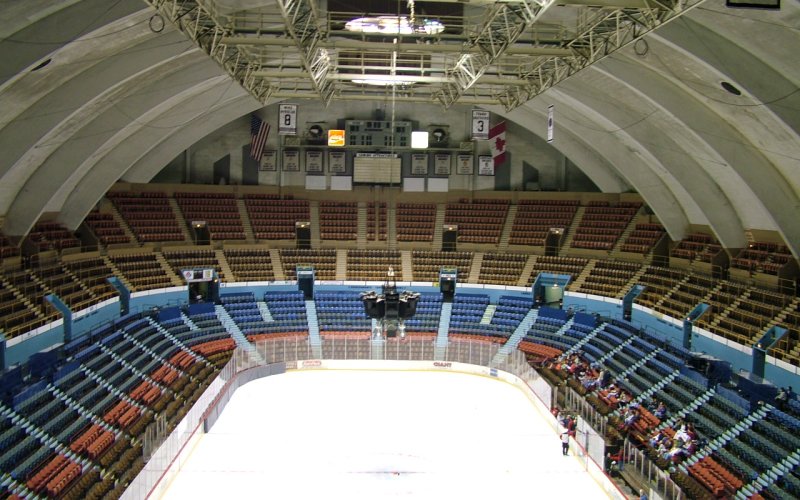
In 2002, Hershey opened the Giant CenterSM, with expanded seating, luxury boxes, and player facilities, that replaced the Arena as the area’s preeminent sports and entertainment venue. The Arena is still an essential part of Hershey’s recreational facilities, hosting youth games and other events.
Hersheypark Stadium
Hersheypark® Stadium was the last structure of Mr. Hershey’s Great Building Campaign, and its purpose was to further develop the Hershey area as a sports center.
The stadium opened in 1939 and hosted professional, collegiate, and high school football teams. Through most of the 50s and 60s, the stadium was the summer training camp site for the Philadelphia Eagles.
The venue hosted Midget Auto Racing, a fan-favorite until the gas rations of World War II rendered it too expensive. The first AACA Antique Automobile Show was held in 1954 and has since expanded into a multi-day show that takes over the parking lot of the Giant Center.
In the 1980s, the Stadium’s capacity for 30,000 fans allowed it to become a tour stop for larger acts. Recent upgrades to the size of the stage makes Hershey a must-stop-city as the biggest names in live touring plan their events.
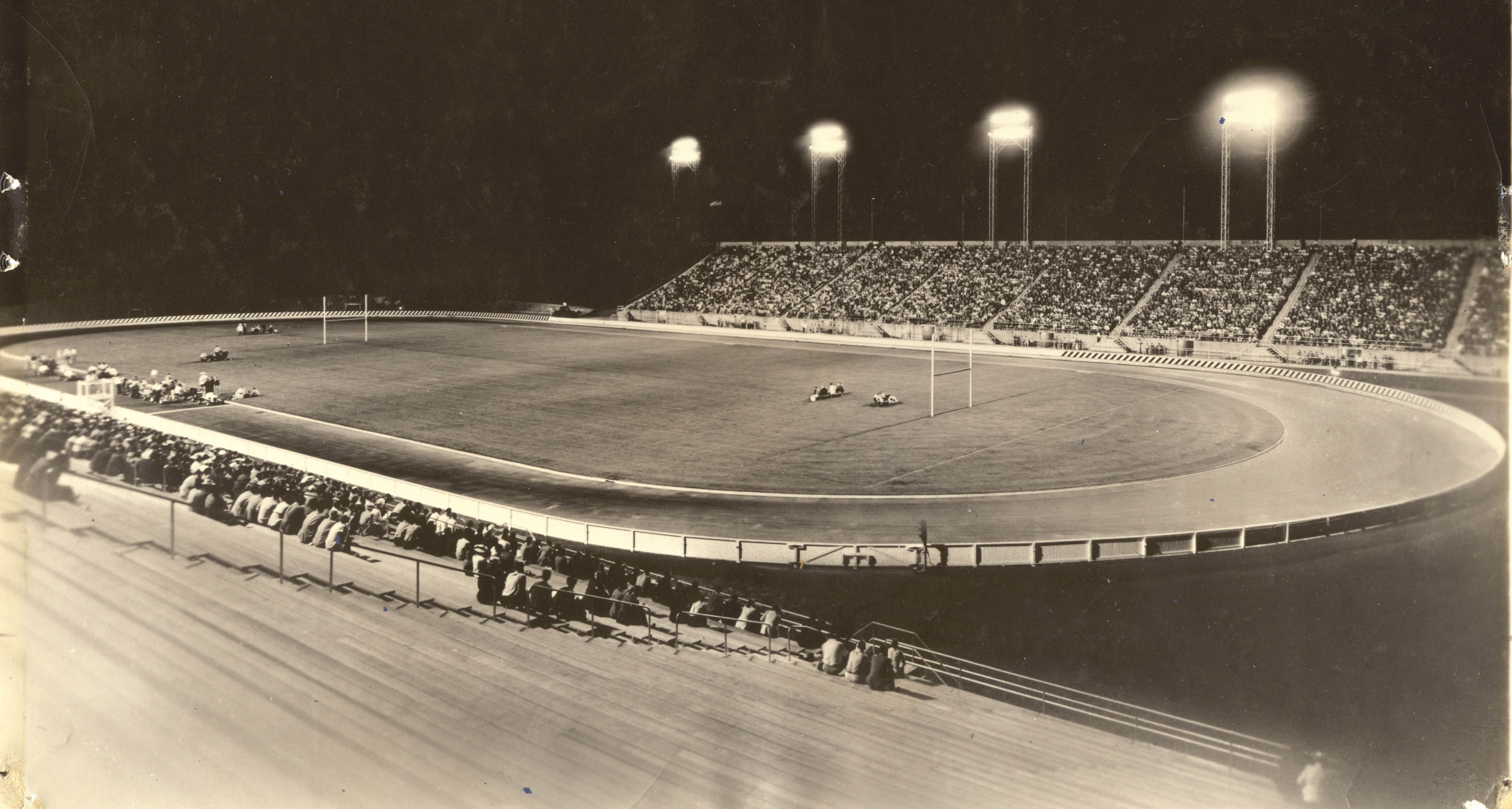
More Historic Spaces
In addition to the structures of his Great Building Campaign, Mr. Hershey left a lasting legacy throughout the town.

Hershey Gardens
Visitors who are fond of horticulture and botany will want to explore the Hershey Gardens, a 23-acre public garden next door to The Hotel Hershey. J. Horace McFarland of Harrisburg wrote to Mr. Hershey, advocating that he invest in a public rose garden. It just so happened that Mr. Hershey was thinking of expanding the rose garden at his home, so the timing of McFarland’s idea was perfect. In November 1936, 12,000 rose bushes in 450 varieties were planted, and the Gardens opened in June 1937, welcoming more than 200,000 visitors in its first season. Today the grounds of the Gardens include themed gardens, a children’s area, an educational wing, and a tropical Butterfly Atrium.
Hersheypark
As part of Mr. Hershey’s grand plan for his chocolate factory and model town, Hersheypark® was in the works as the factory itself was under construction. Its original facilities included picnic pavilions, slides, swings, see-saws, a dance pavilion, a baseball diamond, and lighted walkways and structures powered by the chocolate factory next door.
Mr. Hershey’s model town piqued people’s interest and brought visitors by train and trolley. Hersheypark quickly became a tourist attraction, and over the years Mr. Hershey added an amphitheater, miniature railroad, swimming pools, carrousel, roller coaster, bumper cars, and water flume ride.
In 1975, Holiday Magazine named Hersheypark the cleanest and greenest amusement park in the United States. Hersheypark continues to pride itself in creating a modern space that keeps the traditions of the past alive. The park is home to an 11-acre water park, a zoo, and Hershey’s ChocolatetownSM, a space anchoring the park entrance featuring shopping, dining, and rides.

ZooAmerica
Besides the squirrels and birds, the first animals to take up residence at Hersheypark were 12 prairie dogs sent to a local man, Franz Zinner, by a former neighbor. Unsure of how to take care of these exotic gifts, Zinner reached out to Milton Hershey, who agreed to keep them as a park attraction. When Zinner’s generous friends sent him a black bear cub, Zinner and Hershey conceived an idea to build a zoo.
During Mr. Hershey’s lifetime, the Hershey Zoo welcomed animals by donation, including deer, zebus, possums, goats, pheasants, and peacocks. Over the years, the Zoo increased its collection of exotic creatures like monkeys, a lion, tropical birds, baby elephants, penguins, anacondas, and orangutans.
Today, ZooAmerica® North American Wildlife Park includes more than 200 animals native to this continent, from the Southern Swamps to Big Sky Country. Zoology and animal education are essential elements of the Zoo’s vision, and eager animal lovers are offered a chance to go behind the scenes for unique experiences.
High Point Mansion
Milton and Catherine Hershey moved into High Point Mansion in 1908. Named "High Point" to signify its place on an elevated space overlooking the original chocolate factory, the mansion was modest compared to the homes of other wealthy industrialists of the time.
The home's design features elements of both Colonial and Greek revival architecture styles. The layout featured an open concept first floor, grand staircase to the 2nd floor, and 22 rooms.
Tour reservations are available online via The Hershey Story's website. Tours are offered most Saturdays at 9:30 AM, 11 AM, 1 PM and 2:30 PM. Tickets are limited.

Milton Hershey School
Milton Hershey and his wife, Catherine (Kitty), unable to have children of their own, used their wealth to establish a home and school for orphaned boys. The Milton Hershey School, then called the Hershey Industrial School, opened in 1910 and provided a stable home life, rigorous academics, and agricultural and vocational disciplines.
Mr. Hershey established a living legacy to ensure the continuation of his vision long after his death. The generosity and philanthropy of Milton and Catherine Hershey has touched thousands of lives, and their dreams endure today for more than 2,000 students a year who receive a world-class education and a life-changing experience at no cost.
Founders Hall is home to the school's Visitors Center. Guests can learn about the school's history as a moving program is projected onto the curved second tier of the rotunda. The Visitors Center is open Monday through Saturday 10 AM to 3 PM.
Historical Photos Courtesy of Hershey Community Archives, Hershey, PA.
More Ways to Learn about Milton Hershey
The Hershey Story, The Museum of Chocolate Avenue, offers a fascinating look at the life of Milton Hershey from his early business failures to his selfless philanthropy. It's fittingly located in the heart of Downtown Hershey on Chocolate Avenue.
Hershey Trolley Works tours roll through the town of Hershey with entertaining guides who love to share stories about the town and its beloved founder.
Explore the Hershey History Center for collections and exhibits that look back on the town's sweet beginnings.
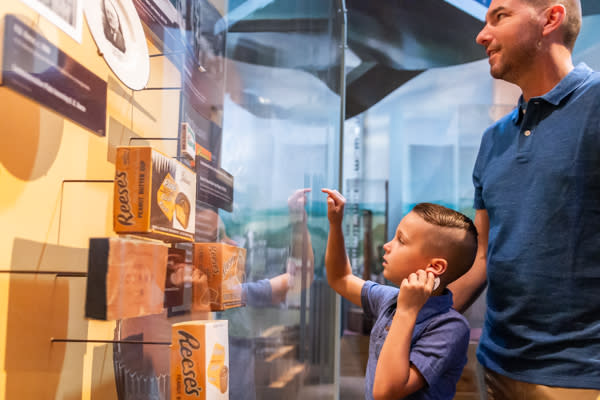
Cookies are used for optimization and tracking. By continuing to use our site you agree to our privacy policy.
Cookies are used for optimization and tracking. By continuing to use our site you agree to our privacy policy.
